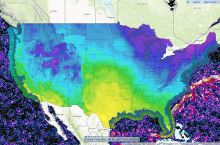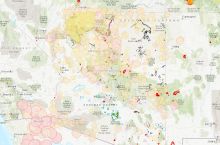Wildfires are causing more frequent and wider-ranging societal impacts, especially as residential communities continue to expand into wildland areas. Since 2000, there have been twelve wildfires in the United States that have each caused damages exceeding $1 billion; cumulatively, these twelve wildfires have caused a total of $44 billion in damages.
Basics
Wildfires are unplanned fires that burn in natural areas, such as grasslands, shrublands, forests, or other environments, including wildland areas where people live.1 They can start from both human and natural causes, such as lightning, and they affect every state in the U.S. Nearly 85 percent of U.S. wildfires are from human causes, including uncontrolled campfires, burning debris, sparks from malfunctioning equipment, discarded cigarettes, and arson, accounting for 44% of the total area burned across the U.S.2,3 Read more










